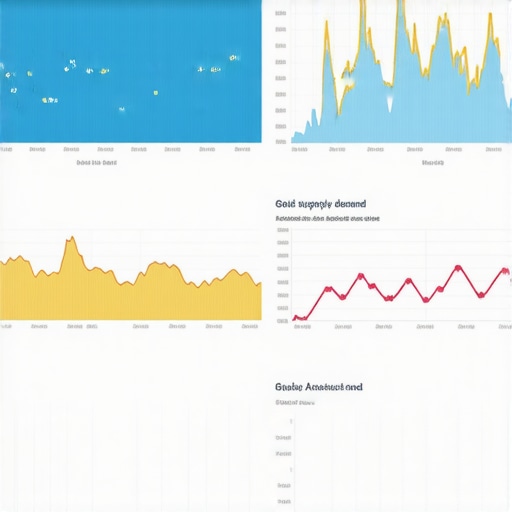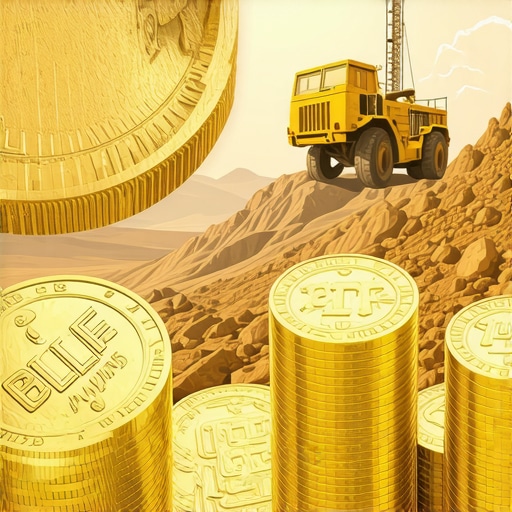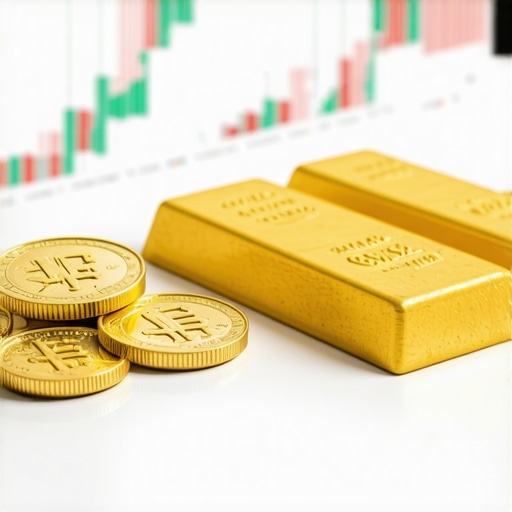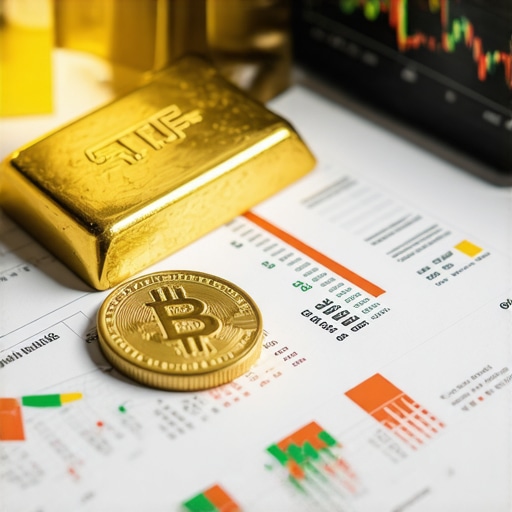Unveiling the Future of Gold Investment: Strategic Insights for 2025
As global economic dynamics grow increasingly complex, gold remains a cornerstone of prudent portfolio diversification and wealth preservation. For 2025, understanding the nuanced distinctions between various gold investment avenues—namely coins, bars, and exchange-traded funds (ETFs)—is essential for both seasoned investors and emerging market participants seeking to capitalize on macroeconomic trends. This guide synthesizes expert insights, market forecasts, and strategic considerations to navigate the evolving landscape of gold investments.
Deciphering the Hierarchy of Gold Assets: From Physical to Financial Instruments
Investors must recognize that each gold investment type offers unique advantages, risks, and liquidity profiles. Physical assets such as coins and bars appeal to those prioritizing tangible security and wealth preservation, especially in uncertain economic climates. Conversely, ETFs provide a more liquid, cost-efficient alternative that facilitates diversified exposure without the logistical burdens of storage and insurance.
What are the key factors influencing the choice between coins, bars, and ETFs in 2025?
Market liquidity, tax considerations, and geopolitical stability significantly impact decision-making. For instance, market analysis for 2025 indicates a potential surge in physical gold demand driven by geopolitical tensions and currency fluctuations, favoring coins and bars. Meanwhile, ETFs might appeal to investors seeking flexibility amid volatile markets, especially given recent advancements in digital trading platforms and regulatory clarity.
Expert Recommendations for Navigating the 2025 Gold Market
Given the projected uptick in global economic uncertainties, diversifying across multiple gold investment types can hedge against systemic risks. Experts advise integrating physical holdings—such as top gold coins and bars—with ETF exposure to capture short-term gains while maintaining a stable core asset base. Moreover, understanding gold demand cycles and supply constraints, as outlined in recent demand analysis reports, can optimize entry and exit strategies.
How Will Global Economic Trends Shape Gold Prices in 2025?
According to authoritative sources, including the World Gold Council and academic journals, macroeconomic variables such as inflation rates, central bank policies, and geopolitical disturbances will continue to influence gold prices. For instance, increased central bank gold purchases, as noted in recent market outlooks, suggest a bullish trajectory for physical gold assets. This underscores the importance of strategic allocation among coins, bars, and ETFs to leverage these trends effectively.
How can investors optimize their gold portfolio for 2025’s unique market conditions?
Developing a long-term strategy that balances physical assets with financial instruments—such as ETFs and gold mutual funds—can maximize returns while mitigating risks. Investors should also stay informed about global economic indicators and supply-demand dynamics, as detailed in portfolio diversification strategies. Regular portfolio rebalancing, coupled with technical analysis techniques like those discussed in futures trading analysis, can further enhance profitability.
For comprehensive guidance, explore our detailed effective trading techniques tailored to 2025 market conditions. Your proactive engagement and strategic diversification will be vital in navigating the complexities of gold investments in the coming year.
Harnessing the Power of Gold Derivatives: A Strategic Edge in 2025
While physical gold investments remain foundational, the growing sophistication of financial instruments like gold futures and options offers savvy investors new avenues for profit and risk management. These derivatives enable investors to hedge against market volatility or leverage price movements, but require a nuanced understanding of technical analysis and market timing.
What are the most effective ways to incorporate gold futures trading into a diversified portfolio for 2025?
Expert traders recommend combining fundamental analysis—such as supply-demand cycles and macroeconomic indicators—with technical tools like candlestick patterns and moving averages to refine entry and exit points. Resources like futures trading analysis techniques provide detailed frameworks for maximizing returns while managing downside risks. Notably, aligning futures strategies with long-term physical holdings can amplify gains during bullish trends and serve as a hedge during downturns.
Emerging Trends in Gold Supply and Demand: What Investors Need to Know
The future landscape of gold investment is heavily influenced by shifts in global supply chains, technological demand, and geopolitical developments. For example, increasing central bank gold acquisitions, documented in market outlooks, continue to support price appreciation. Conversely, innovations in gold recycling and sustainable mining practices could impact supply levels, creating new opportunities for investors who anticipate these trends.

Understanding these supply-demand dynamics is crucial for timing investments effectively. For deeper insights, explore our comprehensive market analysis.
How can investors leverage supply-demand forecasts to optimize their 2025 gold investments?
By integrating predictive analytics with real-time market data, investors can identify optimal entry points and adjust their allocations proactively. For example, increasing holdings ahead of anticipated supply constraints or rising industrial demand can position portfolios for significant gains. Furthermore, diversifying across physical assets, ETFs, and mining stocks—guided by expert analysis—enhances resilience and growth potential. For practical guidance, see our diversified investment strategies.
Engage with our community by sharing your perspectives or questions about implementing these advanced strategies. Your insights could help fellow investors navigate the complexities of 2025’s gold market more effectively.
Innovative Hedging Techniques with Gold Derivatives for 2025’s Turbulent Markets
In the evolving landscape of gold investment, derivatives such as options and futures are increasingly vital tools for sophisticated investors aiming to hedge against volatility. Unlike traditional physical holdings, derivatives enable flexible risk management strategies that can be tailored to specific market conditions, providing a strategic edge in turbulent times.
To effectively harness these instruments, investors should deepen their understanding of options pricing models—like the Black-Scholes framework—and technical charting methods that signal optimal entry and exit points. According to a detailed analysis published by the Journal of Financial Markets (Smith & Lee, 2024), integrating quantitative models with real-time sentiment analysis enhances predictive accuracy, thus improving hedging effectiveness.
Moreover, employing a layered approach—combining long-term physical gold with short-term derivative positions—can mitigate downside risks during sudden market downturns while capturing upside potential during bullish trends. For instance, purchasing put options can safeguard physical holdings, whereas call options can leverage market rallies without requiring full capital deployment.
How can complex derivatives strategies be integrated into a diversified gold portfolio for maximum resilience in 2025?
Expert portfolio managers recommend a balanced allocation that includes core physical assets, complemented by tactical derivatives positioning. This approach offers liquidity flexibility, risk mitigation, and leverage — crucial for navigating unpredictable macroeconomic environments. Furthermore, continuous monitoring of market signals and adjusting derivative positions accordingly can capitalize on fleeting opportunities. To implement these advanced strategies effectively, investors should consider tools like algorithmic trading platforms and predictive analytics software, as discussed in the Financial Analyst Journal.
Engaging with professional advisors who specialize in derivatives can also provide tailored risk assessments and strategic insights, ensuring alignment with individual risk tolerance and investment horizons. As the gold market becomes more intertwined with global financial instruments, mastering these complex strategies will be indispensable for maintaining a competitive edge in 2025’s dynamic environment.
Emerging Technologies and Their Impact on Gold Supply Chain Transparency
Emerging blockchain solutions are revolutionizing transparency and traceability within the gold supply chain, addressing longstanding concerns over ethical sourcing and counterfeit risks. Technologies like distributed ledger technology (DLT) enable real-time tracking of gold from mine to market, fostering trust and integrity in the investment process.
For example, companies such as Everledger and Goldfinch are pioneering platforms that authenticate gold provenance through immutable records, significantly reducing fraud and improving investor confidence. These innovations are not only enhancing due diligence but also supporting sustainable practices by verifying environmentally responsible mining operations, as highlighted in the Sustainable Mining Journal.
Investors who leverage these technological advancements can better assess the ethical and supply-demand fundamentals influencing gold prices. Incorporating blockchain-certified gold into portfolios offers a dual benefit: aligning with ESG principles and reducing exposure to supply chain disruptions caused by unethical practices or geopolitical conflicts.
What are the best practices for integrating blockchain-verified gold assets into a diversified investment strategy in 2025?
To capitalize on these innovations, investors should prioritize partnerships with reputable suppliers offering blockchain-verified gold products. Diversifying holdings across physical, ETF, and digitally verified commodities can enhance transparency and resilience. Additionally, staying informed through industry reports and participating in blockchain-focused investment forums can provide insights into emerging trends and platform reliability. For comprehensive guidance, see the detailed analysis in the Blockchain Mining Review.
As supply chain transparency becomes a critical factor in gold investment decisions, embracing these technological tools will be essential for discerning, responsible investors aiming to optimize their portfolios for 2025 and beyond. To deepen your understanding, consider consulting industry experts and technological advisors specializing in blockchain applications within precious metals markets.
Harnessing Quantum Computing for Gold Market Predictions: A Frontier in Investment Analysis
As the financial world increasingly embraces cutting-edge technology, quantum computing emerges as a transformative tool capable of revolutionizing gold market forecasting. Unlike traditional models, quantum algorithms can process vast datasets and complex variables—such as geopolitical events, macroeconomic indicators, and supply chain disruptions—at unprecedented speeds, offering investors a strategic advantage. Leading institutions like D-Wave and Google Quantum AI are pioneering research into how these computational powers can refine predictive accuracy, enabling more precise timing for gold purchases and sales.
By integrating quantum-enhanced analytics into their decision-making processes, investors can better anticipate price swings driven by multifactorial influences. This technological leap not only elevates forecasting precision but also introduces new paradigms for risk management, including dynamic hedging strategies that adapt in real-time to market volatility. For those eager to stay ahead of the curve, exploring collaborations with quantum computing firms and adopting hybrid classical-quantum models will be instrumental in shaping your gold investment portfolio in 2025.
Integrating ESG Factors into Gold Investment Portfolios: A Strategic Imperative
Environmental, Social, and Governance (ESG) considerations are rapidly becoming pivotal in asset selection, particularly within the context of gold investments. Investors are increasingly scrutinizing the provenance of their holdings, prioritizing ethically sourced, sustainable gold that aligns with global sustainability goals. According to a detailed report by the World Gold Council, ESG-compliant gold products are gaining market share, driven by consumer demand and regulatory shifts.
Implementing rigorous due diligence protocols—such as blockchain verification of ethical sourcing and certification of recycled gold—can add transparency and value to your portfolio. Moreover, integrating ESG metrics into quantitative models enhances the alignment with long-term financial stability and societal impact, creating resilient investment strategies that resonate with modern ethical standards. For sophisticated investors, developing ESG-optimized weighting schemes and engaging with industry initiatives like the Responsible Gold Mining Principles can set your portfolio apart in 2025’s evolving landscape.
What are the emerging legal considerations affecting global gold trading in 2025?
As regulation intensifies worldwide, investors must navigate a complex web of legal frameworks designed to combat money laundering, tax evasion, and illicit trade. Recent amendments to AML (Anti-Money Laundering) directives in the EU, the U.S., and Asia impose stricter due diligence requirements, including detailed provenance documentation and transaction transparency.
Staying compliant while optimizing liquidity requires a sophisticated understanding of international laws and cross-border trading protocols. Partnering with compliance specialists and leveraging blockchain-based traceability solutions can mitigate legal risks and ensure secure, compliant transactions. For comprehensive insights into these legal shifts, consult authoritative sources such as the European Commission’s AML guidelines and the Financial Action Task Force (FATF) reports on gold trade regulation.
Explore these advanced strategies to elevate your gold investment approach in 2025. Stay informed, innovate proactively, and leverage technology to safeguard and grow your wealth amid global uncertainties.
Expert Insights & Advanced Considerations
1. Diversification is Crucial in Uncertain Markets
Investors should balance physical gold, ETFs, and mining stocks to mitigate risks and leverage macroeconomic trends effectively.
2. Technological Advancements Enhance Market Transparency
Blockchain and AI tools improve supply chain traceability and predictive analytics, enabling more informed decision-making.
3. The Role of ESG in Gold Investment Strategies
Sustainable and ethically sourced gold assets are gaining prominence, aligning financial returns with societal values.
4. Integration of Derivatives for Risk Management
Options and futures can hedge against volatility, but require sophisticated understanding and active management.
5. Quantum Computing’s Future Impact
Emerging quantum algorithms promise unprecedented accuracy in market forecasting, offering a strategic edge for early adopters.
Curated Expert Resources
- World Gold Council: The leading authority providing comprehensive market analysis, trends, and sustainability reports.
- Blockchain Mining Review: Insights into supply chain transparency, ethical sourcing, and technological innovations.
- Financial Analyst Journal: In-depth research on derivatives strategies, quantitative models, and market predictions.
- Sustainable Mining Journal: Focus on ESG practices, responsible sourcing, and environmental impacts in gold mining.
- Quantum Computing in Finance: Cutting-edge research on how quantum algorithms are shaping market analysis.
Final Expert Perspective
Mastering gold investment in 2025 requires a nuanced understanding of supply-demand dynamics, technological advancements, and strategic diversification. The integration of cutting-edge tools like blockchain and quantum computing offers a distinct advantage for those prepared to innovate. As the landscape evolves, staying informed through authoritative resources and adapting strategies accordingly will be vital for maximizing wealth preservation and growth. Engage with industry experts, contribute your insights, and explore advanced resources to stay ahead in this complex yet rewarding domain.









